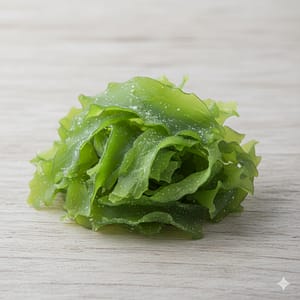- Home
- Sea Lettuce (Ulva lactuca)

I. General Information
A. Scientific Name:
Ulva lactuca
B. Alternative Names:
Sea Lettuce, Green Laver
C. Pronunciation:
see let-iss
II. Sourcing and Origin
A. Source:
Found in shallow, nutrient-rich coastal waters worldwide; cultivated in aquaculture farms.
B. Geographic Origin:
Found worldwide in shallow coastal waters
C. Method of Processing:
Harvested fresh, dried or powdered
III. Properties and Uses
A. Physical Properties:
Bright green, lettuce-like sheets; thin and delicate
B. Chemical Composition:
Protein, fiber, vitamin C, magnesium, iron, chlorophyll
C. Primary Uses:
Skincare: Detoxifying chlorophyll extracts
Haircare: Mineral support for scalp health
Wellness: Digestive and immune support
Culinary: Soups, salads, stir-fries
Household: Green food coloring, nutritional powder
D. Key Benefits:
Fresh, vibrant flavor; rich in vitamin C and chlorophyll
IV. Safety and Considerations
A. Potential Allergies:
Rare, but excessive intake may affect thyroid
B. Best Practices for Use:
Rinse well to remove sand; add at the end of cooking
C. Special Precautions:
Avoid polluted waters; sea lettuce can absorb heavy metals
V. Fun & Educational Facts
A. Historical Context:
Eaten along European and Asian coasts for centuries
B. Did You Know?
Sea lettuce is sometimes used as livestock feed and fertilizer
C. DIY Recipe Idea:
Sea lettuce salad with sesame dressing
Sea lettuce miso soup
Sea lettuce chips
